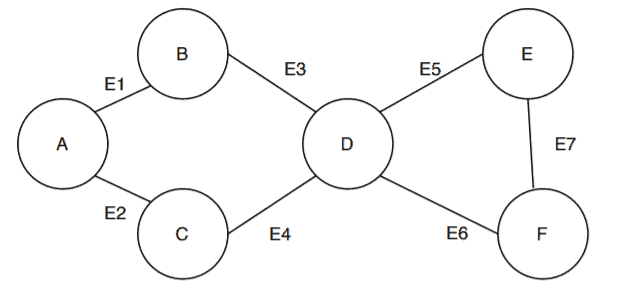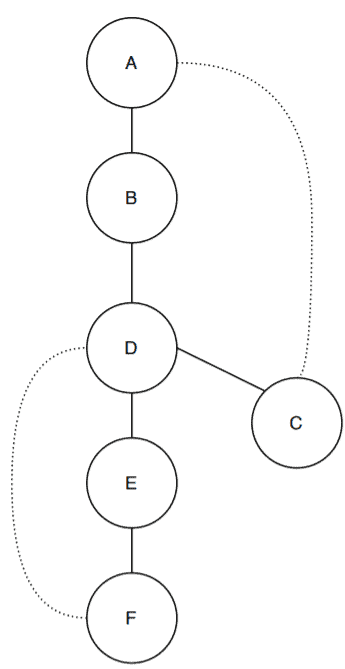1. 概述
在本教程中,我们将讨论关节点(Articulation Points)的概念,以及如何在图中识别它们。关节点是图中非常重要的结构节点,一旦移除,就会导致图的连通分量增加。理解如何识别这些节点,有助于我们评估图结构的鲁棒性和网络的脆弱性。
2. 定义
关节点(Articulation Point) 是指在一个图中,如果移除该顶点及其相连的边后,图将不再连通(即变成两个或更多互不连通的子图),则该顶点被称为关节点。
关节点也常被称为“割点(Cut Vertex)”,是图中连接多个子图的关键桥梁。
我们的目标是找出图中所有的关节点。
3. 示例
我们来看一个无向图的例子:

图 G₁ 包含顶点集合 V = {A, B, C, D, E, F, G} 和边集合 E = {E₁, E₂, E₃, E₄, E₅, E₆, E₇, E₈, E₉}。
如果我们尝试移除顶点 A 及其相连的边 E₁ 和 E₃,图仍然保持连通,因此 A 不是关节点。
但如果我们移除顶点 E 及其相连的边 E₅、E₆、E₇、E₈,则图会被分割为两个连通分量:
- 分量 C₁:顶点集合 {F, G},边集合 {E₉}
- 分量 C₂:顶点集合 {A, B, C, D},边集合 {E₁, E₂, E₃, E₄}
这说明 E 的移除导致图断开,因此 E 是一个关节点。
4. 查找所有关节点的算法
我们可以使用基于 DFS(深度优先搜索)的算法来高效地找出图中所有关节点。
algorithm ArticulationPoints(G, s):
// INPUT
// G(V, E) = 一个图,包含顶点 V 和边 E
// s = DFS 的起始顶点
// OUTPUT
// 打印出图中所有的关节点
构建 DFS 树
初始化 Visited, depth, low 数组
Visited[s] <- true
depth[s] <- d
low[s] <- d
for 每个 s 的邻接点 k:
if k 未被访问:
ArticulationPoints(k, d + 1)
low[s] <- min(low[s], low[k])
if low[k] >= depth[s]:
if s 不是根节点 或 其子节点数量 > 1:
print(s + " 是关节点")
✅ 算法核心逻辑
- 构建 DFS 树,记录每个节点的访问顺序(depth)
- 维护 low 数组,表示当前节点通过回边能到达的最小 depth 值
- 如果子节点的 low 值 ≥ 当前节点的 depth 值,则当前节点是关节点
- 根节点只有在有多个子树时才是关节点
⚠️ 注意事项
- 需要处理回边(back edge)的情况
- 必须递归处理每个未访问的邻接点
- 判断根节点是否为关节点时,需要统计其子节点数量
5. 图上演示算法执行过程
我们以图 G₂ 为例,演示算法的执行过程:

✅ 构建 DFS 树
从 A 出发,构建 DFS 树如下:

我们访问顺序是:A → B → D → E → F → D → C
注意:F 到 D 和 C 到 A 的虚线边是回边,不属于 DFS 树。
✅ 计算 depth 和 low 值
| 顶点 | depth | low |
|---|---|---|
| A | 1 | 1 |
| B | 2 | 1 |
| C | 6 | 1 |
| D | 3 | 1 |
| E | 4 | 3 |
| F | 5 | 3 |
low 值的计算依赖于回边能到达的最浅节点。例如:
- E 的 low 值为 3,因为通过回边到达 D(depth=3)
- B 的 low 值为 1,因为通过回边到达 A(depth=1)
✅ 判断关节点
以 (D, E) 为例:
- low[E] = 3 ≥ depth[D] = 3 ✅
- D 不是根节点 ✅
=> D 是关节点
类似地,我们还可以判断出 C 和 E 也是关节点。
6. 时间复杂度分析
该算法基于 DFS,因此其时间复杂度与 DFS 相同。
- 若图使用邻接表表示,DFS 的时间复杂度为 **O(V + E)**,其中 V 是顶点数,E 是边数。
- 因此,查找所有关节点的算法时间复杂度也为 **O(V + E)**。
这是非常高效的,适合处理大规模图结构。
7. 应用场景
关节点在实际中具有重要意义:
- 网络脆弱性分析:如果一个网络中存在关节点,那么该网络存在单点故障风险。
- 社交网络分析:用于识别连接不同群体的关键人物。
- 交通网络优化:识别关键枢纽节点,防止因某节点失效导致整体瘫痪。
- 最大流问题:在 max-flow min-cut 定理中,关节点常用于确定关键断点。
8. 总结
本文介绍了一个基于 DFS 的经典算法,用于识别图中的所有关节点。我们通过一个具体图示演示了算法的执行过程,并分析了其时间复杂度。
理解关节点的概念及其查找方法,有助于我们在图结构分析、网络设计、系统容错等方面做出更稳健的决策。